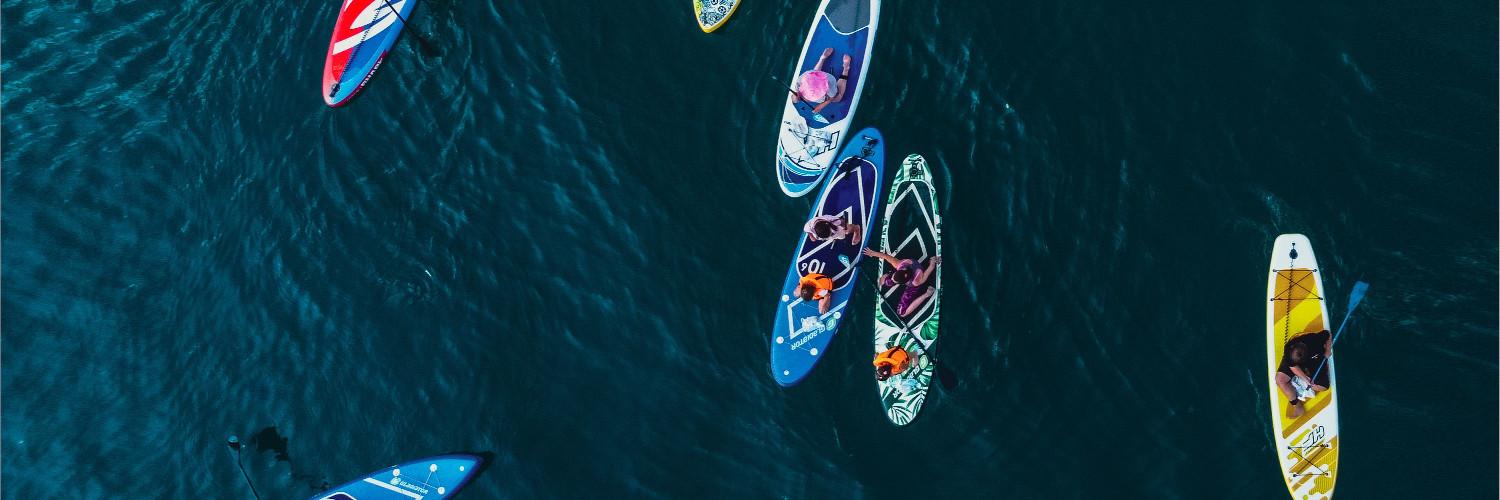Selecting the right size for a stand-up paddle (SUP) paddle is crucial for efficiency, comfort, and performance on the water. The ideal paddle length varies depending on the paddler’s height, the type of paddling they will be doing, and the size of the paddle board itself. For most paddlers, the standard method to determine the correct paddle size involves standing the paddle next to them and ensuring it reaches a certain height above their head—typically 3-4 inches for general paddling.
Paddle boards come in various sizes and shapes, influencing the choice of paddle length. Boards designed for speed and racing might pair better with a slightly longer paddle for powerful strokes, while those used for surfing generally work well with shorter paddles to enhance maneuverability. Additionally, paddlers should consider the paddle’s construction, as adjustable paddles offer versatility and can be tailored to different activities or shared between users of different statures.
For beginners, stability is a key factor, and this might necessitate a paddle that complements a wider and longer board. Width and thickness of the board also affect its buoyancy and load capacity, and thus should be matched with a paddle length that allows paddlers to maintain an upright, comfortable stance without overreaching or straining, ensuring an enjoyable experience on the water.
Understanding SUP Sizing Basics
Determining the correct size for a stand up paddle (SUP) board and paddle is crucial for optimal performance on the water. The length of the paddle, board dimensions—including width and volume—and the weight capacity play pivotal roles in this selection process.
The Role of Paddle Length
For any stand up paddle boarder, the paddle length is vital to ensure efficiency and comfort during use. A common rule of thumb is to choose a paddle that is approximately 3-4 inches above the user’s head when stood upright. This sizing allows for proper posture and stroke mechanics. For instance, the suggested method by Laird Hamilton relies on this principle for quick and effective sizing.
Board Size and Impact on Performance
The size of a paddle board significantly affects its performance. An average paddle board size is often within the range of 31 to 33 inches in width for a balance of stability and maneuverability. Generally, a wider board provides more stability, which is especially helpful for beginners. The length of the board affects speed and tracking; boards ranging from 9'6" to 11' in length are commonly recommended for novice adults.
Weight Capacity of SUPs
The weight capacity of a SUP is a critical specification that correlates with its volume and thickness. A SUP’s volume, expressed in liters, indicates its buoyancy and the ability to support weight without compromising on stability. To find an appropriate size, one should multiply their weight in kilograms by a factor that aligns with their skill level (e.g., by 2 for beginners) to identify a suitable board volume. This consideration ensures that the board can adequately support the rider and maintain performance standards.
Finding the Right SUP for Your Activity
When selecting a stand-up paddle (SUP) board, the intended activity significantly influences the board’s size, shape, and design to ensure optimal performance and maneuverability.
SUPs for Surfing and Racing
Surfing SUPs are typically shorter with a narrower nose and tail to enhance maneuverability on waves. They usually range from 7 to 10 feet in length, enabling quick turns and responsive handling during SUP surfing sessions. On the other hand, racing SUPs are long and narrow, ranging from 12.6 to 14 feet, designed to cut through water with minimal drag ensuring high speeds and straight tracking for competitive racing.
Touring and Recreational Paddle Boards
Touring paddle boards are built for distance and efficiency. They often measure from 11 to 14 feet in length and feature a pointed nose to promote glide and reduce resistance over long distances. These boards balance performance with stability which is essential for touring purposes. Recreational SUPs are versatile, generally measuring 10 to 12 feet. These boards are wide, offering stability for casual recreational paddling, and are well-suited for beginners.
Specialty SUPs for Fishing and Yoga
Fishing SUPs are designed with extra width, typically between 32 to 36 inches, to provide stability for anglers to cast and move without tipping. They often come with mounts for fishing gear and storage options. Yoga SUPs require a wide and stable platform as well, prioritizing space and balance over speed, making them ideal for fitness enthusiasts looking to practice yoga on the water.
Choosing the Right SUP Paddle
Selecting the appropriate SUP paddle is crucial for performance and comfort. Paddle choice encompasses materials, design, and proper sizing for the paddler’s height and intended use.
Material and Construction of Paddles
SUP paddles are crafted from various materials, each affecting the paddle’s weight, rigidity, and overall performance. Carbon fiber paddles are lightweight and offer excellent stiffness, translating to efficient energy transfer during paddling. Fiberglass is a mid-weight option, balancing performance with cost-effectiveness, while aluminum and plastic paddles serve as durable and economical options for beginners.
- Shaft: Typically made from carbon, fiberglass, or aluminum.
- Blade: Usually constructed from carbon, fiberglass, plastic, or a combination.
Adjustable vs. Fixed Paddles
- Adjustable paddles: They offer versatility with variable length, suited for different paddlers or varying conditions. These paddles have a mechanism, often a clamp or twist lock, allowing for length changes generally ranging from 67 to 83 inches.
- Fixed paddles: Tailored for an individual’s specific requirements, fixed paddles are cut to the paddler’s optimal length. They provide a consistent experience and are preferred by enthusiasts who value precision and performance.
Sizing Methods for the Perfect Paddle Fit
Correct paddle sizing ensures maximum comfort and efficiency while paddling.
- Hands Up Method: To estimate the correct paddle length, a paddler can stand with their arm extended upward, and the correct paddle size will place the T-grip handle comfortably in the bend of their wrist.
- Shaka Method: Extending the “shaka” sign - thumb and pinky extended, remaining fingers curled - from the top of a paddler’s head upwards can also provide a quick estimate for the paddle length. Adjust the paddle to reach approximately 6-8 inches above the head, which is suitable for general paddling.
- Laird Hamilton Method: A quick sizing technique advising that the paddle should stand vertically and reach 3-4 inches above the paddler’s height.
In summation, the selection of a SUP paddle should be guided by the material suitability, choice between adjustable and fixed models, and accurate sizing using proven methods for the best fit.
SUP Boards for Different Skill Levels
Selecting the right SUP board varies with skill level; beginners, intermediate, and advanced paddlers will find specific designs suited to their experience. This ensures stability for learners and performance for more skilled enthusiasts.
Boards for Beginners and Kids
For beginners and children, stability is the key concern. They should opt for wider boards ranging from 32 to 35 inches in width, and a length of approximately 10'6" to 11'. These dimensions provide a stable platform that helps with balance and control while learning. Heavier individuals or those with a larger body type might consider a board with more volume to ensure adequate buoyancy.
- Recommended Size for Beginners and Kids:
- Width: 32-35 inches
- Length: 10'6" - 11'
Advanced Options for Experienced Paddlers
Experienced paddlers often seek performance and maneuverability over stability. Boards that are narrower and longer, usually around 29 to 32 inches in width and lengthier than 12 feet, are well-suited to their needs. Advanced users can handle these dimensions, which allow for speed and efficiency in the water.
- Recommended Size for Advanced Paddlers:
- Width: 29-32 inches
- Length: >12 feet
Choosing Boards for Intermediate Users
Intermediate users balance the need for both stability and maneuverability. They might lean towards boards measuring 31 to 33 inches in width, which offer a middle ground suitable for honing skills while still providing a secure feel. Lengths might vary, but a common choice is in the 10.5 to 11.5-feet range.
- Recommended Size for Intermediate Users:
- Width: 31-33 inches
- Length: 10.5-11.5 feet
Additional Considerations When Selecting SUP Gear
When considering SUP gear, it goes beyond just the paddle size. One must also take into account the board material and shape as well as key features and accessories that can enhance the overall SUP experience while maintaining safety on the water.
Influence of Board Material and Shape
Materials: The choice between an inflatable SUP (iSUP) and a hard board, typically made of epoxy, can influence the performance and portability of the board. Inflatables are known for their ease of storage and transport, making them a popular choice for those with limited space. Hard boards, on the other hand, offer better speed and stability, especially in choppy waters.
- Shape and Stability: Board shape significantly affects stability and control. Wider boards offer more balance, making them suited for beginners or for those practicing SUP yoga poses. Narrow, longer boards are designed for speed and better tracking but demand a higher skill level for proper control.
Assessing Board Features and Accessories
Board Length and Volume: Matching the board length and volume to your weight is crucial for optimal performance. A board with the right volume will properly support your weight, ensuring stability and control. Ensure the maximum weight capacity suits your needs.
Features: Look for boards with mounts and attachments if you plan to add accessories like GPS units, fishing rods, or cameras. Additionally, considering the thickness of the board can affect the volume and load capacity, which is particularly important for activities that require more gear, such as SUP touring or fishing.
Maximizing Enjoyment and Safety on the Water
Safety: Always consider the environment you’ll be paddling in. Calmer waters might require less attention to board volume and load capacity, but for rougher, more unpredictable waters, choosing a board with better stability and weight capacity can be critical for your safety.
- Enjoyment: Your enjoyment on the water is enhanced when you have the right SUP gear that meets your individual needs. Whether you opt for a versatile all-around board for various water conditions or a hybrid that can adapt to different activities, your enjoyment hinges on the suitability of the gear for your intended use.
Selecting the right SUP gear is more than just finding the correct paddle—it’s a holistic approach that considers the interaction between the board’s material, shape, features, and water conditions to ensure a safe and enjoyable experience.





